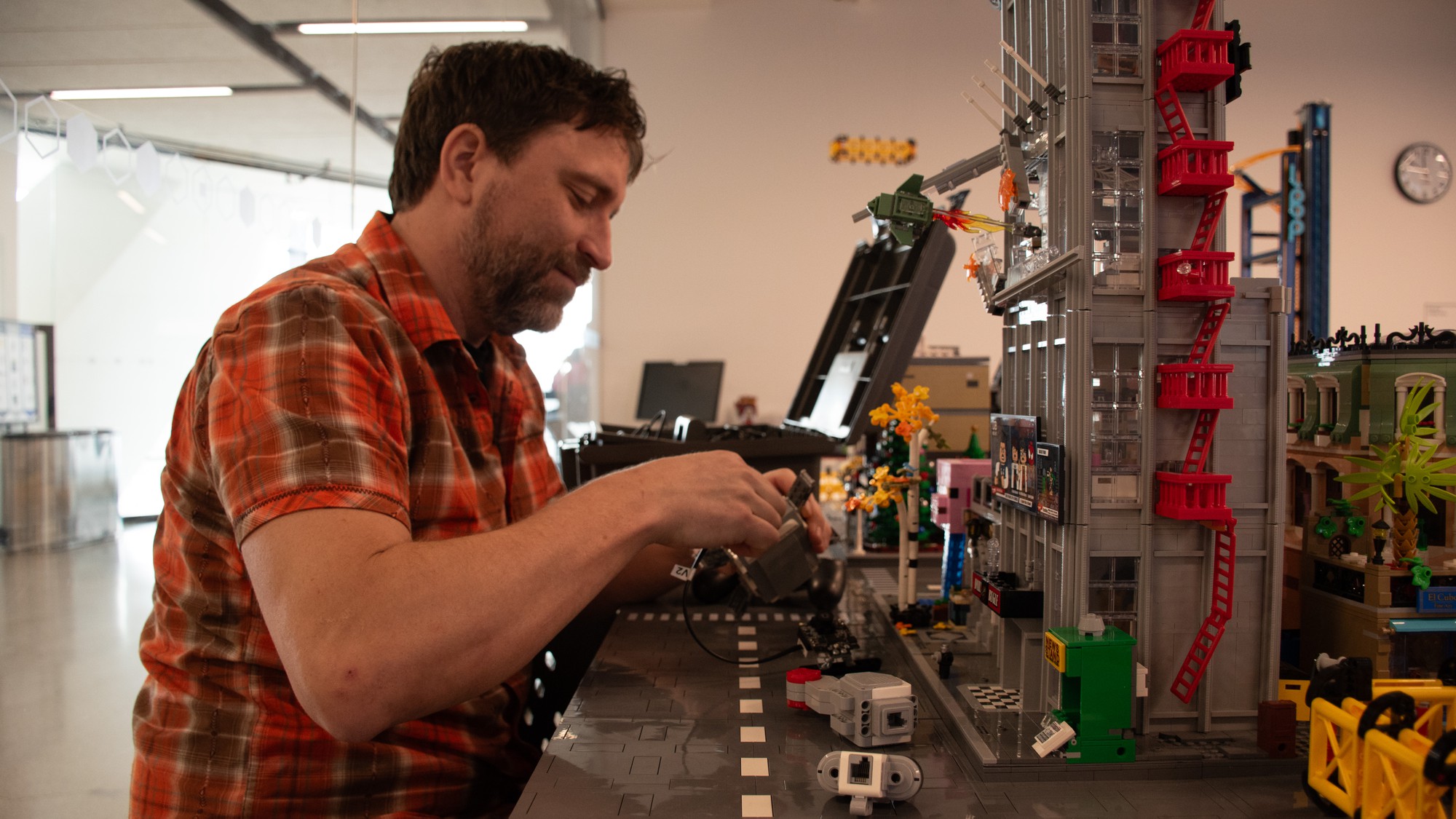By Delroy Davidson, Krishna Bhagnathsingh
It started as a coding project for a robotics class about seven years ago. But it became something bigger.
Much bigger. Indeed, it became a mini-city built of Lego blocks, and construction continues so that it becomes a living model of an urban area.
Adam Thomas, a coding professor in the Faculty of Media and Creative Arts at the Humber North campus, implemented something new to coding that transformed into the model.
“I teach coding and probably about seven years ago, we decided to bring robotics into an introduction to coding class,” he said. “That slowly grew into building a whole city and having developer students code different aspects of the city.”
The goal of this labour-of-love Lego project has grown to become a city made out of the coloured blocks constructed by Thomas and students.
The Lego City is located on the third floor in room 306 in the Barrett Centre. Thomas said any program or person is welcome to go see the Lego structure, it would just have to be arranged with the faculty.
He said the plan is to hold drop-ins on the last Tuesday of every month from 11 a.m. to 2 p.m. He said Lego drop-in session dates and times are posted on the Student Wellness and Accessibility website, but registration is necessary.
“I loved Lego as a kid,” Thomas said when asked if he has ever had an interest in Lego. “When I had kids, we started using Lego again and it was fun.
“There’s something therapeutic about it,” Thomas said. “When kids are playing with Lego, it’s quiet, nobody’s fighting, everyone’s interested. Most of us played with Lego as a kid, so there’s something comforting and easy about it,” he said.
He said the project began as a low-barrier entry to robotics.
“Sometimes students struggle with code or think they’re going to struggle with code, but if you put a bunch of Legos in front of them, I think it boosts your confidence,” Thomas said.
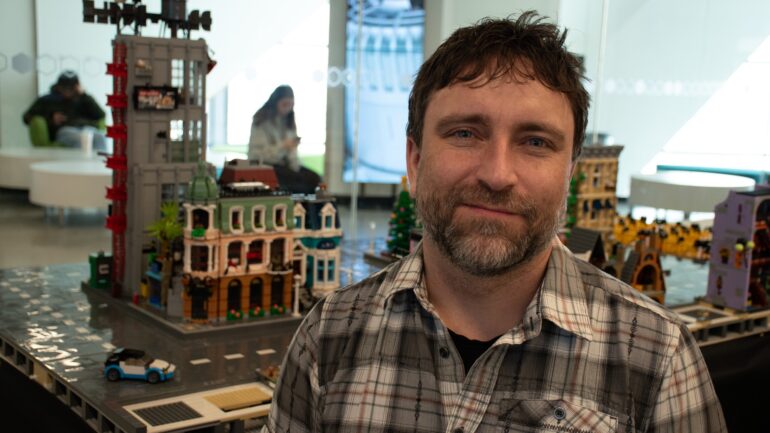
Adam Thomas, a professor in the Faculty of Media and Creative Arts. Thomas is the organizer of this Lego project. Photo credit: Krishna Bhagnathsingh
The Lego city will soon include automated vehicles and traffic lights.
Thomas said there are around 20 buildings as of right now.
“I think the whole city is about 12 by 16 feet,” Thomas said. “We measure it in Lego studs.”
Thomas said the city is 10 base plates long by nine base plates wide.
“It’s going to be nine by 12 base plates,” he said.
Thomas said more than 181 kilograms (400 pounds) of Lego have been used to construct the city. The work also includes more than 100,000 lines of code, 70 per cent written by students.
Thomas said the project expanded by having students from numerous programs finding ways to contribute.
“We started doing robotics a long time ago, and then it grew, and when it took the form of the city it was given the name BrickMMO,” Thomas said.
BrickMMO is the name of the whole project. Thomas said the smart city is just a part ofthe project.
“The vision is to make a physical, working video game,” Thomas said. “We’re trying to get as many programs involved as possible, so we’ve run some hackathons with interior design, the radio program and industrial design.”
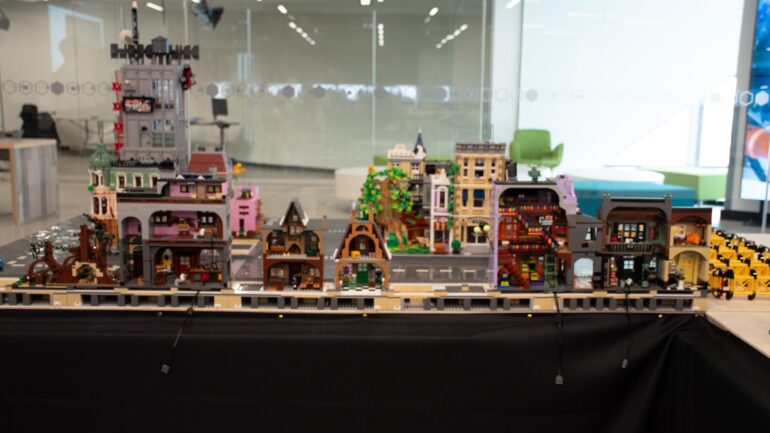
A picture of the Lego city. This is just a part of the project that Humber students and staff are working on. Photo credit: Delroy Davidson
He said the hackathon format includes students designing something and then having judges pick a winning design, and then it’s implemented into the Lego city.
“We have prizes,” Thomas said. “When we buy this much Lego, we get lots of free Lego as prizes for some of these competitions.”
Thomas said the sessions here are to get students to come together.
“We have lots of Lego kits that need to be built, so I’m just looking for help, but students find it relaxing and a chance to be social,” he said.
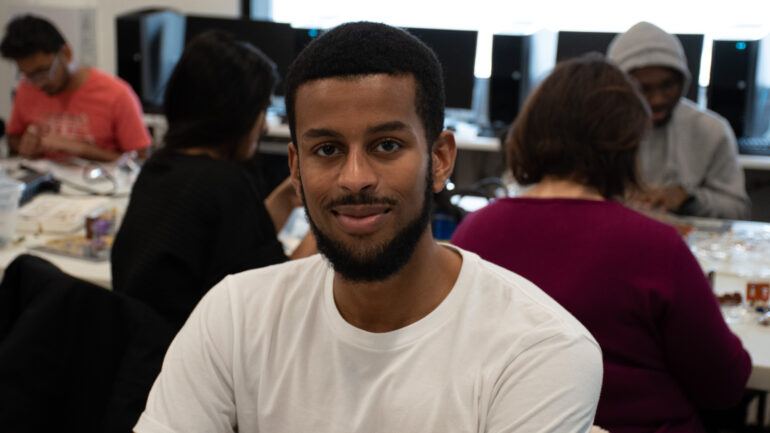
Erko Abdurahman, a student in the web development post-graduate program at Humber. Abdurahman gained interest in the Lego drop-in session when it first started and is a contributor to the project. Photo credit: Krishna Bhagnathsingh
Erko Abdurahman, a student in the Web Development post-graduate program at Humber, said when Thomas started hosting drop-in sessions, that’s when he was interested.
“My professor, Adam, for one of my classes in September mentioned that he was working with some partners to do this building event for BrickMMO, which essentially is like a Lego city that operates on its own,” he said.
Abdurahman said Lego was something he was interested in when he was younger.
“I used to play with a lot of Legos, but as I gotolder I didn’t really get as much time,” he said.
Abdurahman said Lego is expensive now, another factor that influenced him to step aside from building Lego.
“It kinda got me back into it slightly because I even have a couple of sets on my own,” he said.
Abdurahman said the drop-in session is an opportunity for socialization and stress relief from school.
“I’m very new to programming so there’s a steep learning curve and when I’m at home, I’m usually studying or doing some other stuff,” he said.
Abdurahman said it’s relaxing to be able to go to a drop-in session, build Legos and listen to music.
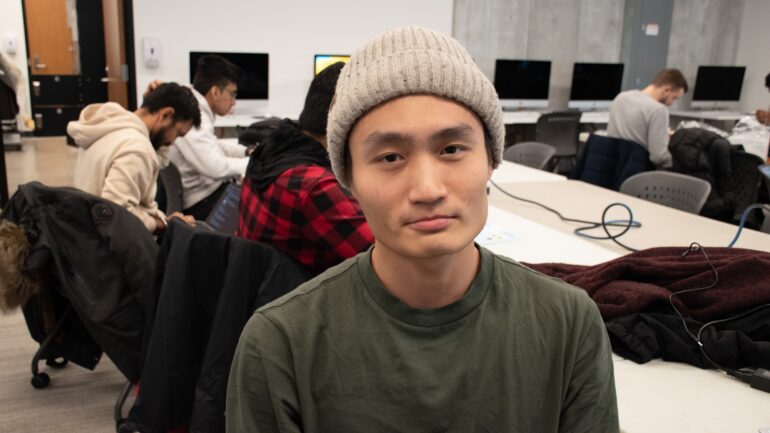
Bailey Liang, a student in the web development program at Humber. Liang is one of the many students participating in this Lego project. Photo credit: Krishna Bhagnathsingh
Bailey Liang, a student in the Web Development program at Humber, said he first attended Lego drop-in sessions because it was an opportunity for one of his courses.
“One of my professors introduced us to this BrickMMO City project opportunity,” Liang said. “So I think every Friday we would just come in and just have a drop-in session every morning.”
Liang said he has been to almost all of the drop-in sessions.
“I wouldn’treally call myself a Lego fan,” he said.
Liang said Lego makes programmable devices that can interact with other Lego pieces and that got him interested.
“You can program a device and then you could program it to control pieces of Lego that you could build big systems,” he said.
Liang said he is here for the socialization but is interested in experimenting with the Python Lego programmable bricks and hubs, which the drop-in session gives him a chance to do.
“In general, it’s just a nice vibe,” Liang said.

